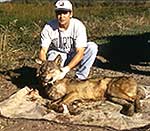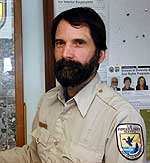By Bob Reha
Minnesota Public Radio
March 28, 2002
|
| RealAudio |
Wolves continue to thrive in Minnesota, and the process to remove them from the Endangered Species List continues. While that is good news for the species, it will present new wolf management problems. Near Thief River Falls in the northwestern corner of the state, new research showing wolves are little threat to livestock worries some farmers.
| |
|
|
|
||
Andreas Chavez is a graduate student from Utah State University. He's completing a two-year study of the two wolf packs roaming the Agassiz Wildlife Refuge.
"The importance of it was - it was one of the first studies that was able to document what was going on between wolves and livestock," he says.
Chavez looked at the potential threat of the wolves to livestock in the area, and the perceived threat of the packs to farmers and ranchers.
"The actual threat seemed really low, given that there were only an average of two depredation incidents a year," says Chavez. "The risk is determined by other factors, such as the availability of wild prey for the wolves."
Chavez says wolves are reputed to kill for no reason. He says this view is based on myth and legend, instead of research and facts. Chavez says if other food is available, the chances of wolf attacks on livestock diminish. He says the Agassiz Refuge has a plentiful supply of deer.
Chavez's findings bring little comfort to some local farmers, like Roger Kilen. He farms cattle and sheep near the north gate of the Agassiz Wildlife Refuge.
| |
|
|
|
||
It's been a tough night for Kilen. Something has been spooking his cattle. He believes it was wolves.
"I had them on the north side of them feed bunks, in that loft there. They went through the east end and then they went through the corner," he says.
Kilen says the wolf problem is frustrating. Government trappers have been some help, but still he has lost animals.
"We got 10 of their...timber wolves - we caught a mile south here," Kilen says. "They come right up behind my house and they (took) 25 sheep - and took them a mile and a half south. They killed six of them that night."
Kilen says all they found was a few patches of wool.
Ronnie Peterson's farm is one mile south of Kilen's. He says this has been a good winter - he hasn't lost any cattle to the wolves.
"The other years before that - I've lost four in one year," says Peterson. "I lost a cow that was giving birth. The calf was halfway out and they killed her, and they ate the calf right up to the tail head of the cow and then left."
| |
|
|
|
||
Peterson considers the Agassiz Refuge a good neighbor. Refuge staff are willing to help him when he has problems with the wolf pack. But he's skeptical of the study. It only covers two years. Given how many animals he's lost in the past, it's hard for him to accept the idea that wolves pose little threat to livestock.
"I don't have no use for them. They are at the top of the food chain out there," says Peterson. "If they keep up too much, there'll be too many here and it'll be just them left. And they're no good to eat."
Still, Peterson says he can coexist with the wolves if farmers are allowed to kill problem animals.
Gary Huschle, a biologist at the Agassiz Wildlife Refuge, says the study shows future local deer management plans must make maintaining the wolf's food supply a top priority. He says the study also shows the Agassiz wolves are resilient in the face of human attempts at control.
"In the future when we do start managing wolves, they will be able to replace the pack members that are lost through legal harvest and survive - and do quite well," he says.
Huschle says Chavez's study is a valuable tool for the refuge's staff. They are preparing for the eventual lifting of federal protection for the wolf. At that time they will share management responsibilities for the wolf population with the Minnesota DNR.
More from MPRMore Information



